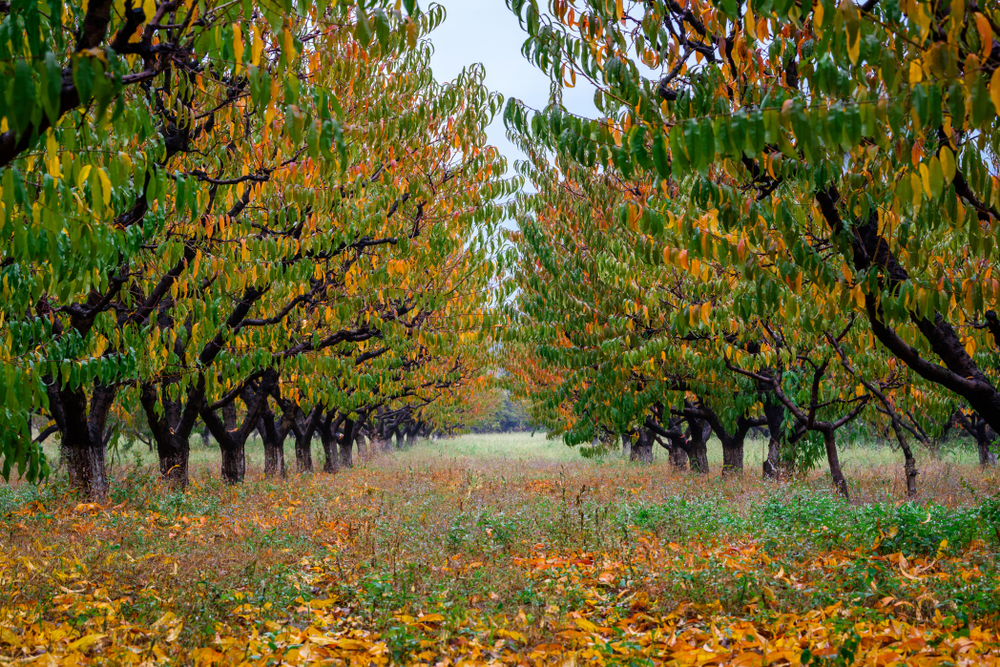Have you recently planted a peach tree hoping for an excellent yield, only to find the tree fruited peaches smaller than you’d have liked? Let’s explore why your tree wasn’t as fruitful as others and what you can correct to help next year’s crop.
Tree Location

A peach tree in less-than-ideal conditions yields less fruit. The location your tree has been planted determines how well it fruits. Consider these tips when picking a spot for your peach trees.
- Full Sunlight: Peach trees grow best when left in full sun conditions without shade.
- Elevation: Peach trees planted at higher elevations avoid the cold air, which inhibits growth.
- Well-Draining Soil: Soil that drains well with a loamy or sandy consistency is the best soil for planting peach trees.
- Prepare Soil: Adding compost or other organic material to the area you plan on planting ensure rich soil for your tree.
- Depth: Plant peaches around 10 to 12 inches deep and no deeper. Trees planted too deep may have slow growth or die.
Preferably, the soil should be amended before planting, but if you’re already dealing with tiny, hard fruits adding nutrient-rich organic matter may help. Specific fertilizers can also help improve the soil.
Crowded Conditions
Thinning is one of the most effective ways to yield larger, more desirable fruit. Though the process takes time, the payoff should be large, juicy peaches.
How Thinning Works
Peaches absorb what they need from the soil and from sunlight through the photosynthesis process. All of the fruit on your tree grows by sharing these resources. Excess fruiting means fewer resources to go around, resulting in small, low-quality fruit.
Thinning also benefits your tree by preventing limb breakage from overburdened branches. By removing excess, the remaining fruits have more resources to draw from.
Thinning Peaches
Thin peaches in one of two methods: pruning or blossom reduction.
Pruning
Pruning branches before they blossom prevents small crops. Pay special attention to the center of the tree. Fruit obstructed by branches tends to be smaller in this area, and cutting off fruit-bearing branches here will help other fruits grow larger.
Also, remove fruiting branches less than eight inches long since these also yield smaller fruit. Trimming back longer pre-bloom branches to no less than 12 inches is also effective.
Blossom Thinning
Blossoms can also be thinned to increase the size of peaches. Large-scale growers use mechanical and chemical methods for this process, but it can also be done by hand. Damaging flowers will decrease yields, diverting more resources to the remaining fruit.
Peach Leaf Curl
Diseases also affect fruit size though it may take time to take effect. One of the most common is peach leaf curl, a fungal infection affecting all tree parts, including decreasing yield.
Peaches that are tiny aren’t the only sign of this garden problem. Infected fruits develop corky-textured crack spots on the skin. This is an uncommon symptom, but just because your fruit isn’t scarred doesn’t mean your peach tree is healthy.
Look first for reddish patches on growing leaves. If you notice these leaf areas are thick or curling, there is a good chance your tree has peach leaf curl. Luckily, there are cultivars resistant to the fungus if your area is prone to the disease.
Applying fungicide after the leaves have fallen off your peach tree yearly will also keep your trees free of disease.
Final Thoughts
Many of the reasons why trees produce little peaches can be remedied. You can take steps like thinning your trees’ limbs, amending soil, or other treatments. Even if you’re dealing with small fruit, there’s always hope for a better yield next year!
